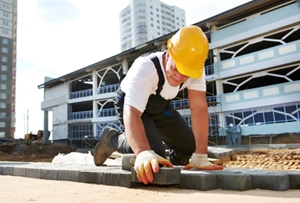Unlocking the Secrets of Lasting Masonry Building And Construction Practices for Eco-Friendly Buildings
In the world of modern building, the search of sustainable techniques has become paramount. Amongst the myriad methods to green building, lasting stonework building stands out as a reliable and sturdy approach that holds a wealth of untapped capacity. From the choice of products to ingenious building methods, the tricks to accomplishing sustainability within stonework building are diverse and interesting. By checking out the advantages, products, techniques, and future fads of sustainable masonry, a much deeper understanding of just how these methods can shape the future of environmentally friendly buildings arises.
Advantages of Sustainable Masonry Building And Construction
Welcoming sustainable stonework building and construction methods not only minimizes ecological impact yet also supplies lasting economic benefits to builders and areas. By utilizing materials like recycled blocks, blocks, and stones, home builders can significantly lower the carbon footprint of their projects while promoting source efficiency. Furthermore, sustainable masonry building and construction methods, such as appropriate insulation and thermal mass buildings, can improve energy efficiency within buildings, causing minimized functional expenses over time.
In addition, the resilience and strength of masonry frameworks contribute to lasting economic advantages. Buildings built making use of sustainable masonry methods commonly need less maintenance and fixing, equating to set you back financial savings for home builders and homeowner. The longevity of masonry materials additionally makes certain that structures continue to be stable and protected, reducing the need for frequent improvements or replacements.
Eco-Friendly Masonry Materials
Making use of environment-friendly stonework materials is a pivotal step towards enhancing the sustainability of building techniques and reducing environmental influence while optimizing long-lasting financial advantages. Lasting masonry products are sourced, generated, and made use of in a fashion that minimizes general environmental effect. Lasting concrete blocks integrate recycled aggregates and might feature enhanced insulation buildings, adding to power effectiveness in buildings.
Additionally, all-natural materials like adobe, rammed earth, and straw bundles offer excellent thermal mass properties, minimizing the requirement for heating and cooling power. These materials are often in your area readily available, promoting local economic situations and minimizing transportation-related carbon emissions. By selecting environment-friendly stonework materials, building projects can considerably minimize their ecological footprint and add to the development of much healthier, more lasting constructed environments.
Energy-Efficient Stonework Strategies
Energy performance plays a crucial duty in enhancing the sustainability of stonework building and construction methods. By applying energy-efficient masonry methods, builders can dramatically decrease the general power intake of a structure, resulting in lower functional costs and a smaller environmental footprint. One key energy-efficient stonework method is using thermal mass, which involves incorporating thick products like concrete or brick into the building's framework to soak up and save heat. This assists manage interior temperature levels, decreasing the demand for mechanical home heating and cooling down systems.

Advancements in Lasting Stonework
Current developments in lasting stonework methods have actually produced cutting-edge methods that are reshaping the building industry. One such development is the development of self-healing concrete, which utilizes microorganisms embedded within the concrete to heal cracks autonomously. This innovation not only lowers upkeep prices yet likewise improves the longevity of stonework structures, adding to their sustainability.
Another noteworthy advancement is making use of recycled accumulations in masonry building and construction - masonry contractor. By including products such as smashed ceramic waste or recycled glass right into concrete blends, builders can decrease the environmental effect of building and construction projects while maintaining architectural honesty. This technique not only diverts waste from land fills yet likewise preserves natural deposits, making it a crucial development in sustainable masonry building
Moreover, great site the integration of electronic layout tools, such as Structure Details Modeling (BIM), is revolutionizing the way stonework frameworks are prepared and created. BIM permits even more accurate estimations, lowered material wastefulness, and enhanced energy performance, eventually leading to even more lasting building methods. These developments collectively indicate a promising future for sustainable masonry building in the period of green structures.
Future Trends in Masonry Sustainability
With the innovative strides made in lasting masonry techniques, the future fads in masonry sustainability are positioned to further revolutionize the building and construction sector. Among the essential patterns shaping the future of stonework sustainability is the increased integration of technology. Advancements such as Building Details Modeling (BIM) and virtual reality simulations are being used to enhance stonework building and construction procedures, resulting in decreased material waste and improved power effectiveness in structures.
Additionally, the development of unique lasting products is readied to play a significant role in improving the eco-friendliness of masonry building. masonry contractor. Developments like self-healing concrete, recycled aggregates, and bio-based binders are getting grip for their capacity to minimize ecological effect while maintaining architectural integrity

Conclusion
In conclusion, lasting masonry construction practices use numerous advantages for environment-friendly buildings. masonry contractor. Technologies in lasting stonework are constantly being created to better boost the environmental performance of buildings.